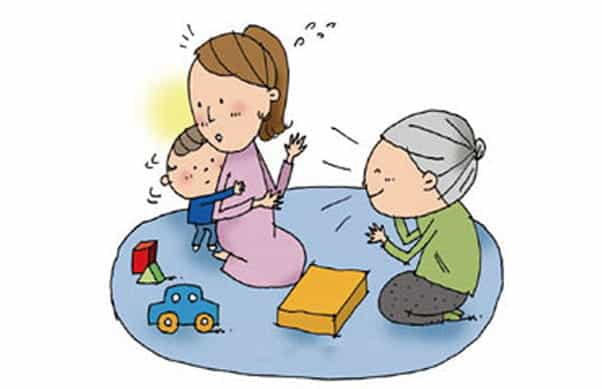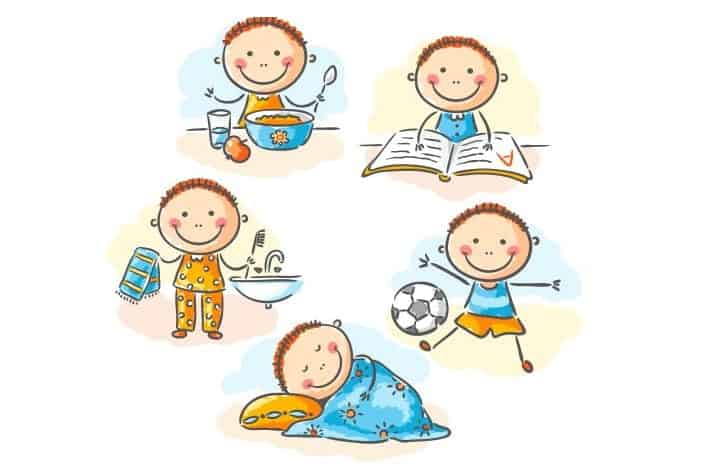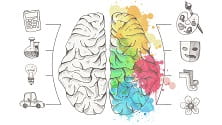Another two months passed. Two more and our girl will be 2 years old! But this period still contains a lot of surprises and rapid development. From speech, and emotions to awareness and new behaviors. Let’s dive in to see what can we expect from a toddler in twenty-first and twenty-second month of life
Article Contents
1. Fear of the strangers or Stranger Anxiety2. Dealing with challenging behaviors
3. First time at the dentist
4. Dealing with transitions and establishing new routines
4.1. Transition to the big bath
4.2. Night weaning
4.3. Starting to love the car rides
If you are more interested in the first year, we got it covered in the first year of a child’s life section so you can start there. And if you are at the beginning of your parenting role, we suggest you start with the first month of the newborn’s life.
Fear of the strangers or Stranger Anxiety
One thing that we noticed in the twenty-first month is a lot stronger fear of strangers. Our little one was never a fan of the unknown people (she is more of an animal person). But now, her behavior and emotional reaction became more intensive.
Going next to unfamiliar people in the open is no problem, but as soon as someone addresses her, she runs to the safety of mom or dad and starts to say: “Let’s go, let’s go!” Also, she is not a fan of crowded indoor spaces. Big shopping malls and stores are mostly fine, but museums or any other small, cramped spaces are a no, no.
But that is to be expected. This phase even has a name, stranger suspicion or more commonly known stranger anxiety. It doesn’t appear suddenly but grows steadily, mostly from the eighth month and lessens in the second year. But it is not uncommon to stay strong until four years of age.

Fear of strangers is a sign of cognitive development and a more complex way of thinking. It is a totally rational fear. Since things (or people) that we don’t know can be potentially dangerous, it is expected to be wary. And when that scary, big, unknown person starts to talk to us, get into our face and even tries to touch us, who wouldn’t be afraid?! With still limited knowledge about the world and people in it, toddlers still don’t know what to expect so fear is a natural reaction.
Fear is stronger toward males than females in most of the children. Also, the closer the stranger is, and further, the caregiver is, the higher the chances that the child will react with fear. Those are some good guidelines to prepare yourselves next time you may meet some unknown people.
So how to deal with stranger anxiety? The most important thing is to stay safe harbor for your child. Don’t ignore or ridicule child feelings, it can make things only worse! The child needs to feel that it can come to you and you will protect it. If the child wants you to take it or wants you to hug it, it’s good to do it at that moment because it will help the child to feel safe. Secure attachment to the primary caregiver is the most important thing for healthy emotional development in the child so we must provide support for our child no matter what emotions it is feeling.
Also, if you know the child will meet a new person, talking about it and preparing the child can go a long way in reducing the fear. You can also step further away from the scary person since the distance is an important factor in the intensity of fear.
And if some child ever shows fear towards you, here are some tips:
- Don’t try too hard. Children need space and time to observe first to see if you are “safe”.
- By far the best tactic to connect with a child is to start doing something interesting to them. Start alone and don’t mind the child. When it is ready, it will come to you since children’s curiosity is so much stronger than fear. It works like a charm every time.
Dealing with challenging behaviors
Why do children misbehave anyway? Do they want to provoke us? They really seem to know how to push our buttons. Sometimes it seems they do it on purpose.
But in truth, they really don’t want to misbehave. They are exploring, testing, breaking, learning – all the stuff they really need to be doing in this phase. But sometimes their exploration is making us crazy. Like when they explore will the yogurt stay in the cup if they turn it upside down. Or when they take stuff apart to see what’s inside. They observe not only their surroundings but us as well. They test how will we react if they oppose us. They learn how all the relationships work through this, first and the most important relationship in their life. No pressure!
Children have some basic needs and usually, all the trouble comes when those needs are not fulfilled. You already know how hunger or tiredness could be triggers for a meltdown. But besides those physical needs, there is also a need for love and affection, exploration and learning, feeling secure and feeling respected.
Toddlers need discipline, but probably not what many people consider when they think of discipline. We shouldn’t hit, yell, threaten, bribe, punish or label them as bad. That doesn’t mean to be permissive and to let a child do whatever.
Positive discipline means setting and keeping boundaries, but in a respectful way. We correct behavior, never the child. The key is to try to understand a child’s need behind behavior and try to fulfill that need in a way that’s acceptable. Children actually need and love boundaries. They show them that we have everything under control and that they can trust our caretaking.

Frankly, I wasn’t so sure about all of this until we got L. It certainly looked great in a textbook but in real life? How will they learn if there is no “punishment”? Why would they stop if we don’t yell or threaten?
The answer to all this is simple – connection. Children crave connection with us, we are the most important people in their lives. They look how big and smart we are and they trust us with their little hearts. They see us as infallible and all-knowing. We, of course, are none of those things but don’t tell them. Puberty will come soon enough.
So because of that faith in us, they let us guide them without much questioning. They want that guidance because it shows them we care and that we look after them. We are the leader of the pack so to speak and they can relax knowing they are safe.
But as mentioned, the connection is a prerequisite for any attempt at guidance. Make them laugh, tell them a story, hug them and show them how much you love them first. Only after that, you can expect them to change their behavior and follow your lead.
Sometimes it can be really hard. Unexplained mood shifts. Screaming for no obvious reasons. Saying yes and no at the same time and getting upset no matter what you do. We need to remember that’s perfectly normal in this developmental phase. Intense emotions and limited vocabulary can make a deadly combination. We don’t understand what they want and they don’t understand how we don’t understand. Frustration everywhere.
Sometimes we are scared of these strong emotions and we try to avoid them very, very hard. We say “maybe later” when we mean “no”, we distract, we make excuses. That may look okay at that particular moment (screaming stopped!), but in the long run, it’s actually not helping our child.
How to stay connected then? How to show we are firm but supportive? It’s often our emotions that are the culprit – we are not sure in our decision and then we project it to our child.
Say clearly what you mean. “No, I can’t let you do that because it’s dangerous.” or “No, sweats after lunch.” Sometimes that extra no is helpful to show how serious we are.
Usually, it’s better to leave that for specific situations, because too much usage can make it lose its effectiveness. And it can also cause resentment – nobody likes to feel controlled all the time. Instead, we try to use more positive speech. What do you want your child to do? Instead “Don’t climb on the bookshelf” we say “Only books go on the bookshelf, let’s climb on the stairs.” Instead “Don’t spill the yogurt on the floor” we use “Drink yogurt and then we can play with water in the bathtub”.
Yes, those behaviors can be annoying in that form, but they are actually perfectly valid needs of toddlers – climbing and exploring liquids. Almost everything else has an “okay” counterpart and we just need to look a bit more to discover it.
Emotions are okay, but we need to be okay with them as well. That was one of the bigger shifts in thinking for us. We should express sadness, we should express anger, we don’t have to be happy all the time. It’s actually not healthy to be happy all the time, because that’s just not possible.
We need to help out children work through their emotions by naming them and talking about them. You would be surprised how quickly they can pick up when somebody is sad or angry. We can’t hide our emotions, so it’s better to acknowledge them and model how to express them. Try to validate their emotions as well. It’s so powerful to hear “It’s okay to feel angry. I would also feel it if that happened to me.”
It sends a message: “We are similar. I hear you and understand you. You are okay the way you are!” And that’s the most important thing we need to carry from our childhood.
First time at the dentist
Most people don’t like to go to the dentist, right? Or is it just me? There are obvious reasons for that. We got conditioned that dentist equals pain. The sound of the drill makes me squirm. And because of that we avoid going until it’s really urgent. So it’s a high probability the next visit will be painful again.
Children are even more sensitive to first impressions. That’s why it’s so important that first contact with the dentist goes in the most playful and fun way possible. Pediatric dentistry is actually the whole field of dental medicine! There are many unique things about baby or “milk” teeth, but they are not less important than permanent. In fact, good oral care of milk teeth makes it more likely to have healthier permanent teeth.

So when is the right time for the visit? Some say ideally 6 months after the first tooth emerged, some say around the first birthday. What’s most important is that you go before any actual need arises. This first visit (and hopefully others as well) should be just prevention and familiarization.
What makes a good child dentist? Well, most of the things that make anyone good with children. Ability to get on their level, interest them in their surroundings and feel when the child is ready to trust them with the scary stuff, like opening their mouth or sitting on the dentist’s chair. For us, another important thing was that our dentist is a woman, because, in this phase, L. is more scared of men, especially bearded men.
We already talked about how important it is to prepare the child before exposing them to new things. Describe where they will go and who will they meet. We explained how we are going to the teeth doctor and what will happen. We said that we will look around and play with some toys first and then we will meet a doctor. She will show us around and then take a look in L’s mouth. She was fine with that and very eager to go.
When we came to the dentist’s office, we first played alone with their impressive stash of toys and books. They gave us lots of space to explore and didn’t engage with L. until she was comfortable. Then we talked to the dentist about our teeth cleaning habits. She explained what bacteria are and how they can damage our teeth. The dentist then used little figurines to show how she will look into L’s mouth. That was fun! We even sat on a big chair and went up and down. The dentist put a camera inside L’s mouth and we looked at her teeth on the big screen. Everything looks great! The best part was getting a little tooth toy and a commendation letter for bravery.
We will go for another checkup in 3, 4 months. Suffice to say, she can’t wait to go again.
Dealing with transitions and establishing new routines
Oh, those transitions from one routine to another can be really tricky. When dealing with changes, patience is the key. In the last two months, we actually had 3 major transitions: transition to the big Bath, night-weaning, and spending a lot of time in the car.

Transition to the big bath
We still remember last year’s fear of the bath. This time, we had to transition from that little bath to a normal bath. It happened quite suddenly since the little plastic bath cracked so we had little time to prepare our little toddler.
It wasn’t a smooth transition. In the first couple of days, she would start to cry at the mention of sitting in the big bath. We did just a quick wash while holding her over the bath.
After some time, we started clogging the bath and adding more and more toys in it. That piqued her interest. The day we put her favorite plastic panda and dinosaur in the bath was the day she decided to sit. She had a blast! Now, bathing is her favorite activity and she demands it every night.
But it was a process. Took more than a month to go from the first bathing in a big bath to sitting in that bath.
Night weaning
A few months ago we started to prepare for the night weaning. We talked about how at night we shouldn’t drink anything but water. The night is for sleeping, the day is for drinking milk.
The first step was to fall asleep without drinking milk. We said we will stop in a few weeks, then a week, then tomorrow. And the day came! We did our usual bathing, reading stories and breastfeeding in the bed. But we said that after turning off our lamp, she will go to sleep without drinking milk.
It went surprisingly well! She asked for some more stories and cuddles but managed to fall asleep without any problems.
The second step was that, overnight, if she asked to breastfeed, she could, but we reminded her that night is for sleeping.
The third step was offering only water if she woke up over the night. The first 2-3 days it took a bit longer to get her to sleep and she was waking a couple of times over the night. But after some time, the frequency of waking overnight reduced. She even acknowledges that now she only drinks water overnight if thirsty. We are down to usually only one waking around 5 AM. She seems really hungry at that time and happily continues to sleep afterward. For now, that works great for all of us.
Of course, after a hard day and on the rough nights, she may still require breastfeeding, but that is because that is so much more than the need for food or drink. It provides comfort and security. So we are still patient in that transition no matter how much more time she will need.
Starting to love the car rides
L. was never a fan of car rides before. She shed a lot of tears in the car in her first twenty months. But to our surprise, now she loves it!
We had to spend a lot of time on the road in the last two months. So our usual tactic, going on the trip in her naptime was not viable anymore. But we found some new interesting things that made a car ride a joy!
Putting on the slippers (we call them traveling slippers), covering with a little blanket, and putting on her favorite songs made the car ride a joy! We are even upgrading it with each new ride. Book in her hands was the first upgrade. Then she decided to take one plushy on every new ride.
Now, the road trips are so fun that we decided to take one on her second birthday!
So what we learned from these transitions? Patience, understanding and creating fun are the things that are most useful in establishing new habits. If you can make it fun, that is the best way to make the transition successful. If not, you will need good preparation, patience, talking a lot with a child and providing support for strong emotions. Adapting to changes is hard for everyone, but with these things in mind, it should go more smoothly.
And that would be some more important takeaways from 21st and 22nd month with the toddler. As we said, life is still dynamic and unexpected in many ways. Next time we will round the second year so join us then to see what to expect from a 2-year-old toddler.
If you’re searching for some great STEM Activities for Kids and Child development tips, you’re in the right place! Check the Categories below to find the right activity for you.

STEM Science
Videos, guides and explanations about STEM Science in a step-by-step way with materials you probably already have at your home. Find new Science ideas.
Read more
STEM Technology
Videos, guides and explanations about STEM Technology in a step-by-step way with materials you probably already have at your home. Find new Technology ideas.
Read more
STEM Engineering
Videos, guides and explanations about STEM Engineering in a step-by-step way with materials you probably already have at your home. New Engineering ideas!
Read more
STEM Math
Videos, guides and explanations about STEM Math in a step-by-step way with materials you probably already have at your home. Find new Mathematics ideas.
Read more
Psychology
Find out all about development psychology topics that you always wanted to know. Here are articles from child psychology and development psychology overall.
Read more
First year of Child’s Life
Following a Child’s development every month from its birth. Personal experiences and tips on how to cope with challenges that you will face in parenting.
Read more